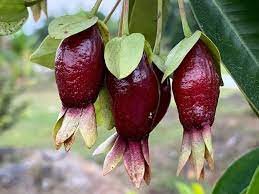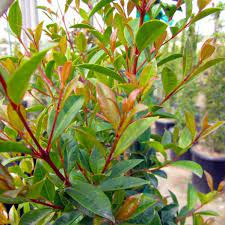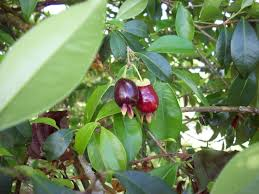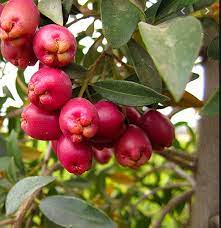Eugenia calycina, commonly known as Brush Cherry, is an evergreen shrub or small tree that hails from Australia. This versatile and attractive plant belongs to the Myrtaceae family and is appreciated for its lush foliage, colorful new growth, and adaptability to various landscaping situations.
Brush Cherry typically reaches a height of 6 to 12 feet, forming a dense and compact habit. The glossy, elliptical leaves are dark green, providing an elegant backdrop to the plant’s overall appearance. One of the striking features of Eugenia calycina is its ability to produce vibrant new growth in shades of red, pink, or bronze, adding an extra layer of visual interest.
During late spring to early summer, Brush Cherry may produce small, inconspicuous white flowers, which are followed by small, berry-like fruits. While the fruits are not necessarily a standout feature, they can attract birds, contributing to the plant’s ecological appeal.
One of the key advantages of Eugenia calycina is its adaptability to different soil types, including well-drained soils in full sun to partial shade. This makes it a versatile choice for a range of landscaping applications, from hedges and screens to foundation plantings. Regular pruning can help maintain a desired shape and size.
Brush Cherry’s resilience and tolerance to coastal conditions also make it suitable for gardens in proximity to the sea. Additionally, it responds well to shaping, allowing for creative topiary designs or formal hedge structures.
With its glossy foliage, colorful new growth, and adaptability to various environments, Eugenia calycina, the Brush Cherry, stands out as a valuable ornamental plant that combines aesthetic appeal with practical landscaping benefits. Whether used for its evergreen backdrop, vibrant foliage, or functional purposes like privacy screens, this Australian native adds a touch of sophistication to gardens and landscapes.
The Botanical Description of Eugenia calycina
1. Family and Genus: Eugenia calycina belongs to the family Myrtaceae and the genus Eugenia. This family is known for including various aromatic plants.
2. Morphology: The plant is an evergreen shrub or small tree with a dense, compact growth habit. Its branches are often covered in aromatic foliage, providing an attractive appearance.
3. Leaves: The leaves of Eugenia calycina are simple, opposite, and elliptical in shape. They are dark green, glossy, and emit a pleasant fragrance when crushed.
4. Flowers: The plant produces small, white, or cream-colored flowers with a delicate and aromatic scent. These flowers are typically arranged in clusters, adding to the ornamental value.
5. Fruits: The fruit of Eugenia calycina is a berry, usually red or dark purple when mature. The berries are edible and may have a sweet or tart flavor, depending on the specific variety.
6. Bark: The bark of the plant is smooth and may have a light gray or brownish color. It provides an interesting contrast to the vibrant green foliage.
7. Growth Rate: Eugenia calycina is known for its moderate growth rate, making it suitable for landscaping purposes. With proper care, it can develop into a well-shaped and aesthetically pleasing plant.
8. Size: The size of Eugenia calycina can vary, with mature specimens reaching heights of 10 to 20 feet. Pruning can be employed to control the size and shape of the plant.
9. Aroma: One of the distinctive features of Eugenia calycina is its aromatic nature. The leaves, flowers, and sometimes the fruit emit a pleasant fragrance, contributing to its popularity in gardens.
10. Ornamental Value: Beyond its practical uses, Eugenia calycina is valued for its ornamental qualities. It is often chosen for landscaping projects, hedges, or as a standalone specimen for its visual appeal.
The Geographic Distribution of Eugenia calycina

1. Native Regions: Eugenia calycina is native to certain regions of South America, including parts of Brazil and Uruguay. It thrives in subtropical and tropical climates.
2. Climate Preferences: The plant prefers warm and humid climates but can adapt to a variety of soil conditions. It is well-suited to areas with consistent temperatures and adequate rainfall.
3. Cultivation in Gardens: Due to its adaptability, Eugenia calycina is cultivated in gardens and landscapes beyond its native range. It can be found in subtropical and tropical regions worldwide.
4. Sunlight Requirements: The plant generally thrives in full sunlight, although it can tolerate partial shade. Adequate sunlight is essential for flowering and fruit production.
5. Soil Types: Eugenia calycina is adaptable to different soil types but prefers well-draining soils. It can tolerate slightly acidic to neutral pH levels.
6. Altitude Range: The plant is typically found at lower altitudes, thriving in elevations ranging from sea level up to moderate altitudes.
7. Invasive Potential: In some non-native regions, Eugenia calycina has shown invasive tendencies. Careful monitoring and management are necessary to prevent ecological disruptions.
8. Landscape Usage: Beyond its native habitat, Eugenia calycina is commonly used in landscaping projects, parks, and gardens in regions with suitable climates.
9. Global Presence: The plant has been introduced to various tropical and subtropical regions globally, contributing to its presence in diverse geographical areas.
10. Microclimates: Eugenia calycina can adapt to different microclimates within its preferred temperature range, allowing for cultivation in various ecological niches.
11. Temperature Sensitivity: While it can tolerate a range of temperatures, Eugenia calycina may experience damage in areas prone to frost or extreme cold. Protective measures may be necessary in colder climates.
12. Ecological Impact: In some regions, Eugenia calycina may have ecological impacts, affecting local flora and fauna. Monitoring its spread and managing its cultivation are important considerations.
The Chemical Composition of Eugenia calycina
1. Essential Oils: Eugenia calycina is known to contain essential oils, contributing to its aromatic properties. These oils may have diverse chemical constituents with potential therapeutic benefits.
2. Polyphenols: The plant is rich in polyphenolic compounds, including flavonoids and tannins. These compounds are known for their antioxidant properties and potential health benefits.
3. Terpenoids: Eugenia calycina may contain terpenoids, a class of compounds with various biological activities. Terpenoids contribute to the plant’s overall chemical complexity.
4. Alkaloids: Some species within the genus Eugenia, to which Eugenia calycina belongs, are known to produce alkaloids. These compounds can have physiological effects and may contribute to the plant’s medicinal properties.
5. Anthocyanins: The red or dark purple color of Eugenia calycina berries is attributed to anthocyanins, which are water-soluble pigments with antioxidant properties.
6. Organic Acids: The plant may contain organic acids, contributing to its flavor profile. These acids can also have implications for the plant’s interaction with the environment.
7. Sugars: Like many fruits, Eugenia calycina berries contain sugars, providing a source of energy for the plant and potential sweetness for consumers.
8. Vitamin C: Eugenia calycina berries are a natural source of vitamin C, an essential nutrient with antioxidant properties. Vitamin C contributes to overall health and immune function.
9. Carotenoids: The plant may contain carotenoids, including beta-carotene, which contribute to the coloration of the berries. Carotenoids are precursors to vitamin A.
10. Lignans: Lignans are another group of compounds that may be present in Eugenia calycina. These phytochemicals have been studied for their potential health-promoting properties.
11. Nutritional Profile: Beyond its medicinal components, Eugenia calycina has a nutritional profile that includes vitamins, minerals, and dietary fibers.
12. Antimicrobial Compounds: Some chemical constituents in Eugenia calycina may exhibit antimicrobial properties, contributing to its traditional uses in folk medicine.
13. Bioactive Peptides: Certain peptides with bioactive properties may be present in Eugenia calycina. These peptides can have implications for human health.
14. Water-Soluble Compounds: The water-soluble compounds in Eugenia calycina contribute to the plant’s overall chemistry and potential health benefits when consumed in various forms.
15. Flavonoids: Eugenia calycina is likely to contain flavonoids, a class of polyphenolic compounds with antioxidant and anti-inflammatory properties.
Read Also: Worm Infestation on Ruminant Animals: Symptoms and Treatment
The Medicinal Health Benefits Of Eugenia calycina (Brush Cherry)

1. Antioxidant Properties: The presence of polyphenols and flavonoids in Eugenia calycina contributes to its antioxidant properties. These compounds help neutralize free radicals in the body, potentially reducing oxidative stress.
2. Anti-Inflammatory Effects: Some components of Eugenia calycina may exhibit anti-inflammatory effects, making it a potential candidate for addressing inflammatory conditions.
3. Immune System Support: The vitamin C content in Eugenia calycina berries can support the immune system, playing a role in maintaining overall health and resilience against infections.
4. Digestive Health: Dietary fibers present in Eugenia calycina contribute to digestive health by promoting regular bowel movements and supporting a healthy gut microbiome.
5. Cardiovascular Health: Certain compounds, such as flavonoids and polyphenols, may have cardiovascular benefits, including the potential to support heart health and manage blood pressure.
6. Antimicrobial Activity: Eugenia calycina’s traditional uses in folk medicine may be attributed to its potential antimicrobial properties, which could help combat certain infections.
7. Potential Anticancer Properties: While more research is needed, some studies suggest that the bioactive compounds in Eugenia calycina may have potential anticancer properties.
8. Cognitive Function: Certain phytochemicals in Eugenia calycina, such as antioxidants, may contribute to cognitive health and potentially support memory and brain function.
9. Skin Health: Antioxidants and vitamin C can benefit skin health by promoting collagen production and protecting against oxidative damage, contributing to a youthful complexion.
10. Respiratory Health: The anti-inflammatory properties of Eugenia calycina may have implications for respiratory health, potentially aiding in the management of respiratory conditions.
11. Blood Sugar Regulation: Some studies suggest that certain compounds in Eugenia calycina may have a role in regulating blood sugar levels, making it of interest for individuals managing diabetes.
12. Potential Anti-Aging Effects: The combination of antioxidants, vitamins, and other bioactive compounds may contribute to potential anti-aging effects, both internally and externally.
13. Stress Reduction: Aromatic compounds in Eugenia calycina may have aromatherapy benefits, potentially contributing to stress reduction and relaxation.
14. Anti-Anxiety Properties: While more research is needed, the plant’s traditional uses suggest potential anti-anxiety properties that may be linked to its calming effects.
15. Joint Health: The anti-inflammatory effects of Eugenia calycina may have implications for joint health, potentially aiding in the management of conditions like arthritis.
16. Nutrient Absorption: The presence of certain compounds may enhance nutrient absorption, supporting overall health by ensuring the efficient utilization of essential nutrients.
The Methods of Usage to Achieve the Provided Health Benefits Of Eugenia calycina (Brush Cherry)
1. Consuming Fresh Berries: Eating fresh Eugenia calycina berries is a direct way to benefit from its nutritional content, including antioxidants, vitamin C, and dietary fibers. Incorporate them into salads, snacks, or desserts.
2. Herbal Teas: Infusing the leaves of Eugenia calycina to make herbal teas provides a convenient way to enjoy its potential health benefits. This method allows for the extraction of water-soluble compounds.
3. Extracts and Tinctures: Creating extracts or tinctures from Eugenia calycina allows for concentrated forms that can be added to beverages or taken in controlled doses. This method is suitable for individuals seeking targeted benefits.
4. Culinary Applications: Integrate Eugenia calycina into various culinary preparations, such as jams, jellies, or sauces. This not only enhances the flavor of dishes but also provides a creative way to consume the plant.
5. Dietary Supplements: For those seeking a more standardized approach, dietary supplements in the form of capsules or tablets can be formulated to deliver specific doses of Eugenia calycina’s bioactive compounds.
6. Aromatherapy: Utilize the aromatic properties of Eugenia calycina by incorporating its leaves or essential oils into aromatherapy practices. This method can contribute to stress reduction and relaxation.
7. Topical Applications: For potential skin benefits, create topical applications such as creams or ointments using Eugenia calycina extracts. This can be particularly beneficial for promoting skin health and addressing certain dermatological concerns.
8. Infused Water: Enhance hydration by infusing water with Eugenia calycina leaves or berries. This provides a refreshing and flavorful way to consume the plant, particularly during warmer seasons.
9. Syrups and Elixirs: Prepare syrups or elixirs using Eugenia calycina, combining its sweetness with potential health benefits. These can be added to beverages or used as drizzles over desserts.
10. Culinary Pairings: Experiment with pairing Eugenia calycina in culinary dishes that complement its flavor profile. This can include both savory and sweet recipes, offering a diverse range of consumption options.
11. Capsules or Tablets: For those who prefer a convenient and measured approach, encapsulate Eugenia calycina extracts into capsules or tablets. This allows for precise dosage control.
12. Poultices: Explore external applications by creating poultices with crushed Eugenia calycina leaves. This method can be used for localized benefits, such as soothing skin irritations.
The Side Effects Of Using Eugenia calycina Medicinal Plant
1. Allergic Reactions: Individuals with known allergies to plants in the Myrtaceae family should exercise caution. Allergic reactions may include skin irritation, itching, or respiratory symptoms. Discontinue use if adverse reactions occur.
2. Gastrointestinal Upset: Excessive consumption of Eugenia calycina berries may lead to mild gastrointestinal upset in some individuals. It’s advisable to start with small amounts and monitor individual tolerance.
3. Photosensitivity: While not well-documented, some individuals may experience photosensitivity when exposed to the sun after using Eugenia calycina topically. Use sun protection measures if applying the plant to the skin.
4. Interaction with Medications: Individuals taking medications should consult healthcare professionals before incorporating Eugenia calycina into their health regimen. Certain compounds in the plant may interact with medications, potentially affecting their absorption, metabolism, or efficacy.
5. Pregnancy and Breastfeeding: Pregnant and breastfeeding individuals should exercise caution and seek guidance from healthcare professionals before using Eugenia calycina. Limited information is available on its safety during these periods.
6. Blood Sugar Levels: Individuals with diabetes or those managing blood sugar levels should monitor their levels carefully when using Eugenia calycina. Some studies suggest a potential impact on blood sugar regulation.
7. Skin Sensitivity: For topical applications, conduct a patch test before widespread use to check for skin sensitivity. Discontinue use if any adverse reactions, such as redness or irritation, occur.
8. Drug Interactions: Eugenia calycina may interact with certain drugs, especially those metabolized by liver enzymes. It’s crucial to inform healthcare professionals about its use when discussing medication regimens.
9. Potential Overconsumption: Excessive consumption of Eugenia calycina, particularly in concentrated forms or as supplements, may lead to unintended health effects. Adhere to recommended dosages and guidelines.
10. Impact on Hormonal Medications: Some compounds in Eugenia calycina may have hormonal effects. Individuals taking hormonal medications should consult healthcare professionals before using the plant to avoid potential interactions.
11. Central Nervous System Effects: In some cases, Eugenia calycina may cause drowsiness or sedation. Individuals operating heavy machinery or engaging in activities requiring mental alertness should use caution.
12. Impact on Blood Pressure: Individuals with blood pressure concerns should monitor their levels, as certain compounds in Eugenia calycina may have cardiovascular effects. Consultation with healthcare professionals is advisable.
13. Prolonged Use Concerns: Long-term or excessive use of Eugenia calycina may pose risks not yet fully understood. It’s advisable to use the plant for defined durations and under professional guidance.
14. External Irritation: When applying Eugenia calycina topically, individuals with sensitive skin may experience irritation. Diluting extracts and conducting patch tests can help minimize this risk.
15. Potential Respiratory Effects: Inhaling the scent of Eugenia calycina or using it in aromatherapy may impact individuals with respiratory conditions. Those with asthma or respiratory allergies should use caution.
16. Individual Variability: Responses to Eugenia calycina can vary among individuals. Factors such as age, overall health, and existing medical conditions may influence how the body interacts with the plant.
Read Also: Different Types of Effective Range Fencing For Animals
The Scientific Research and Studies of Eugenia calycina

1. Antimicrobial Activity: Research suggests that Eugenia calycina may possess antimicrobial properties, inhibiting the growth of certain bacteria and fungi. This property aligns with its traditional uses in folk medicine.
2. Antioxidant Effects: Scientific studies have explored the antioxidant potential of Eugenia calycina, highlighting its ability to neutralize free radicals. Antioxidants are crucial for mitigating oxidative stress in the body.
3. Anti-Inflammatory Properties: Compounds found in Eugenia calycina have demonstrated anti-inflammatory effects in laboratory studies. This suggests potential benefits for conditions associated with inflammation.
4. Phytochemical Analysis: Various studies have conducted phytochemical analyses of Eugenia calycina, identifying specific compounds such as flavonoids, polyphenols, and essential oils. These compounds contribute to its medicinal properties.
5. Cytotoxic Effects: Some investigations indicate that Eugenia calycina extracts may exhibit cytotoxic effects on certain cancer cells. This preliminary research suggests a potential role in cancer treatment.
6. Gastroprotective Effects: Studies have explored the gastroprotective effects of Eugenia calycina, indicating its potential in protecting the stomach lining and reducing the risk of gastric ulcers.
7. Hypoglycemic Effects: Initial research suggests that Eugenia calycina may have hypoglycemic effects, influencing blood sugar levels. Further studies are needed to elucidate its potential role in diabetes management.
8. Anxiolytic Properties: While limited, some studies propose that Eugenia calycina may possess anxiolytic properties, potentially contributing to stress reduction and anxiety management.
The Safety Precautions and Recommendations In Using Eugenia calycina Medicinal Plant
1. Professional Consultation: Before incorporating Eugenia calycina into health regimens, individuals should consult healthcare professionals, especially if they have pre-existing medical conditions or are taking medications.
2. Dosage Guidance: Adhere to recommended dosages provided by healthcare professionals or reputable sources. Avoid self-prescribing, and seek guidance on the appropriate amounts for specific health goals.
3. Allergy Screening: Individuals with known allergies to plants in the Myrtaceae family should undergo allergy screening before using Eugenia calycina. This precaution helps identify potential sensitivities.
4. Pregnancy and Breastfeeding: Pregnant and breastfeeding individuals should exercise caution and seek professional advice before using Eugenia calycina, as limited safety information is available for these populations.
5. Blood Sugar Monitoring: Individuals with diabetes or those prone to blood sugar imbalances should monitor their levels regularly when using Eugenia calycina. Adjustments to diabetes management plans may be necessary.
6. Sun Protection: For topical applications, especially those involving essential oils or extracts, users should practice sun protection measures. Eugenia calycina may cause photosensitivity in some individuals.
7. Monitoring Blood Pressure: Individuals with blood pressure concerns should monitor their levels regularly when using Eugenia calycina. Professional guidance ensures safe integration with existing healthcare regimens.
8. Controlled Use in Children: Due to limited research on the safety of Eugenia calycina in children, it’s advisable to use caution and seek professional guidance before administering it to pediatric populations.
9. Controlled Use in the Elderly: Elderly individuals, especially those with existing health conditions, should approach the use of Eugenia calycina with caution. Professional guidance ensures safety in this demographic.
10. Balanced and Varied Diet: While Eugenia calycina may offer health benefits, it should be part of a balanced and varied diet. Relying on diverse sources of nutrients promotes overall well-being.
11. Holistic Approach: Integrating Eugenia calycina into health practices should be part of a holistic approach to well-being. A combination of a healthy diet, regular exercise, and other lifestyle factors contributes to optimal health.
12. Observation of Individual Responses: Users should observe their individual responses to Eugenia calycina. If any adverse effects, discomfort, or unusual symptoms occur, prompt discontinuation is recommended.
13. Storage and Handling: Proper storage of Eugenia calycina products, such as extracts or supplements, is crucial. Follow recommended storage conditions to maintain their potency and safety.
14. Quality Assurance: Choose products from reputable sources with quality assurance practices. This ensures that Eugenia calycina supplements or extracts meet safety and purity standards.
15. Informed Decision-Making: Individuals should make informed decisions about using Eugenia calycina based on credible information. Awareness of potential benefits and risks contributes to responsible and safe use.
16. Periodic Health Check-ups: Regular health check-ups with healthcare professionals help monitor overall well-being and allow for adjustments to health regimens based on individual needs and changes in health status.
FAQs About Eugenia calycina Medicinal Plant
1. Is Eugenia calycina safe for pregnant women?
While limited information is available, pregnant individuals should exercise caution and consult healthcare professionals before using Eugenia calycina. Professional guidance ensures safety during pregnancy.
2. Can Eugenia calycina be consumed by children?
Due to limited research on its safety in children, cautious use is advised. Consultation with healthcare professionals helps determine appropriate usage in pediatric populations.
3. How does Eugenia calycina benefit skin health?
Eugenia calycina contains antioxidants and vitamin C, contributing to skin health. Topical applications, such as creams or ointments, may provide benefits for skin hydration and protection.
4. Is there a recommended dosage for Eugenia calycina supplements?
Dosage recommendations vary based on individual health goals and formulations. It’s crucial to follow professional guidance or product-specific recommendations to ensure safe and effective use.
5. Can Eugenia calycina interact with medications?
Certain compounds in Eugenia calycina may interact with medications. Individuals taking medications should consult healthcare professionals to assess potential interactions and ensure safety.
6. Are there any known allergies to Eugenia calycina?
Individuals with allergies to plants in the Myrtaceae family should undergo allergy screening before using Eugenia calycina. This precaution helps identify and manage potential sensitivities.
7. Does Eugenia calycina have sedative effects?
Some individuals may experience mild sedation when using Eugenia calycina. Caution is advised, especially for activities requiring mental alertness. Individual responses may vary.
8. How can Eugenia calycina be included in a balanced diet?
Eugenia calycina can be included in a balanced diet through fresh berries, culinary preparations, or herbal teas. Diverse culinary applications contribute to its integration into varied meals.
9. Can Eugenia calycina be used for respiratory conditions?
The anti-inflammatory properties of Eugenia calycina may have implications for respiratory health. However, individuals with respiratory conditions should use it with caution and seek professional advice.
10. Are there any known contraindications for Eugenia calycina use?
Individuals with known allergies, pre-existing medical conditions, or those taking medications should consult healthcare professionals before using Eugenia calycina to identify potential contraindications.
11. How does Eugenia calycina support digestive health?
The dietary fibers in Eugenia calycina contribute to digestive health by promoting regular bowel movements and supporting a healthy gut microbiome.
12. Can Eugenia calycina be used for anxiety management?
Limited research suggests potential anxiolytic properties. Individuals seeking anxiety management should explore this cautiously, considering individual responses and professional guidance.
13. Is Eugenia calycina suitable for individuals with diabetes?
Individuals with diabetes should monitor their blood sugar levels carefully when using Eugenia calycina. Professional guidance is crucial to ensure safe integration with diabetes management plans.
14. Can Eugenia calycina be used for joint health?
The anti-inflammatory effects of Eugenia calycina may have implications for joint health. Individuals with joint conditions should use it with caution and seek professional advice.
15. What is the recommended age for using Eugenia calycina supplements?
Due to limited safety information, caution is advised in children, and use should be guided by healthcare professionals. Adults of all ages can use Eugenia calycina based on individual health goals.
16. How can Eugenia calycina be incorporated into aromatherapy practices?
Eugenia calycina leaves or essential oils can be used in aromatherapy by diffusing the scent. This method may contribute to stress reduction and relaxation.
Read Also: How to Start an Urban Farm

